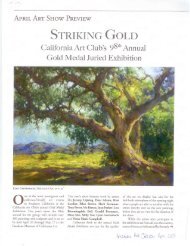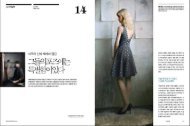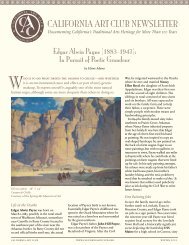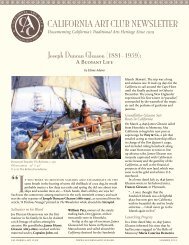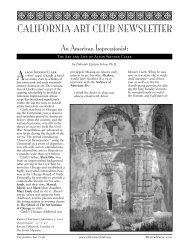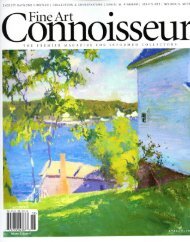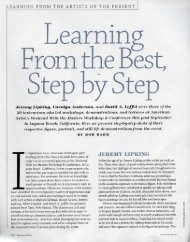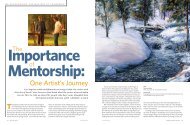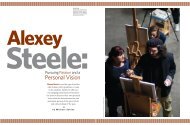(1876-1949) – An American Impressionist, by Deborah Epstein Solon
(1876-1949) – An American Impressionist, by Deborah Epstein Solon
(1876-1949) – An American Impressionist, by Deborah Epstein Solon
Create successful ePaper yourself
Turn your PDF publications into a flip-book with our unique Google optimized e-Paper software.
2<br />
front of him in the only place<br />
available at the time—the<br />
frontispiece and blank rear<br />
pages of the family hymnals.<br />
In 1889 the Clark family<br />
embarked on a two-year trip<br />
around the world. This experience<br />
gave young Alson his first introduction<br />
to European art and perhaps<br />
was the catalyst to his future insatiable<br />
appetite for travel and painting.<br />
We know much about Clark<br />
through his diaries and letters—the<br />
quotidian diary entries for the<br />
young Alson in Europe focused on<br />
food, the weather and his studies,<br />
but also discussed the churches,<br />
museums, galleries, and opera performances<br />
the family attended.<br />
Upon graduating from high<br />
school, Clark briefly enrolled as a<br />
full-time student at The School of<br />
the Art Institute of Chicago where<br />
the traditional academic program<br />
(mostly dependent upon French<br />
principles) included requisite drawing<br />
from casts and still-lifes before<br />
Taking Paintings to the Salon, Paris, c. 1905<br />
Collection of Jean Stern, The Estate of Alson Clark<br />
advancing to the live model. In<br />
1896, following a disagreement<br />
with one of his teachers, and displeased<br />
with what he considered<br />
the slow and laborious process of<br />
drawing from casts, Clark quit the<br />
school. Determined to continue his<br />
studies, Clark moved to New York<br />
to work under the tutelage of<br />
William Merritt Chase<br />
(1849<strong>–</strong>1916) at the Art Students’<br />
League of New York.<br />
Although Clark’s parents supported<br />
his intention to become a<br />
painter, his mother was concerned<br />
about her twenty-year-old son living<br />
alone in New York; so she went<br />
with him. Adding to the unusual<br />
arrangement, Alson’s childhood<br />
friend Amelia Baker joined them.<br />
The three shared a flat at Seventy-<br />
Seventh Street and Columbus<br />
Avenue. According to Sarah Clark:<br />
“For two years Mela [Amelia] and<br />
I have talked of spending a winter<br />
in New York, in Bohemian fashion,<br />
and have searched for a good reason<br />
for doing so, in vain till this<br />
time. Alson, however, came to the<br />
rescue in his desire to study art<br />
with a New York master, and made<br />
it seem a necessary thing to do.”<br />
When Chase opened his<br />
own school, Clark, among<br />
many other students, followed him.<br />
A dedicated and sympathetic<br />
instructor, Chase’s influence on<br />
Clark was enduring throughout the<br />
young artist’s career. In fact, Clark’s<br />
Early Nude (1898) bears an<br />
inscription that Chase actually<br />
worked on the painting. The two<br />
summers Clark spent working en<br />
plein air at Chase’s school in Shinnecock,<br />
Long Island presaged his<br />
inclination towards <strong>Impressionist</strong><br />
practices.<br />
Clark left to study in Paris in<br />
November 1898, but had reservations<br />
about leaving his family. He<br />
wrote in his diaries: “My dear<br />
Mama, how I hate to leave her for<br />
so long. I do love her so.” Aspiring<br />
young <strong>American</strong> painters had several<br />
options for instruction in Paris,<br />
but <strong>by</strong> far the most popular school<br />
was the Académie Julian. Nonetheless,<br />
Clark rejected the Julian, finding<br />
the working conditions there<br />
“disgusting.” Instead, he enrolled<br />
in the newly opened, Academia<br />
Carmen, James Abbott McNeill<br />
Whistler’s (1834<strong>–</strong>1903) short-lived<br />
school. This decision was surprising,<br />
as Whistler was the artistic<br />
antithesis of Chase. Known for his<br />
phlegmatic temperament, Whistler<br />
was ill-suited to the demands of an<br />
instructor. At first, Clark found the<br />
school “rotten.” The tuition was<br />
higher than at other schools, strict<br />
rules of decorum were enforced,<br />
and Whistler’s critiques were often<br />
more theatrical than instructional.<br />
On one rare occasion Whistler<br />
held a small soirée for his students<br />
at the studio. There, Clark acquired<br />
insight into Whistler’s working<br />
methods:<br />
He showed us several of his<br />
starts and finished pictures.<br />
They were elegant and really<br />
almost came up to the Old<br />
California Art Club www.californiaartclub.org Winter/Spring 2006



